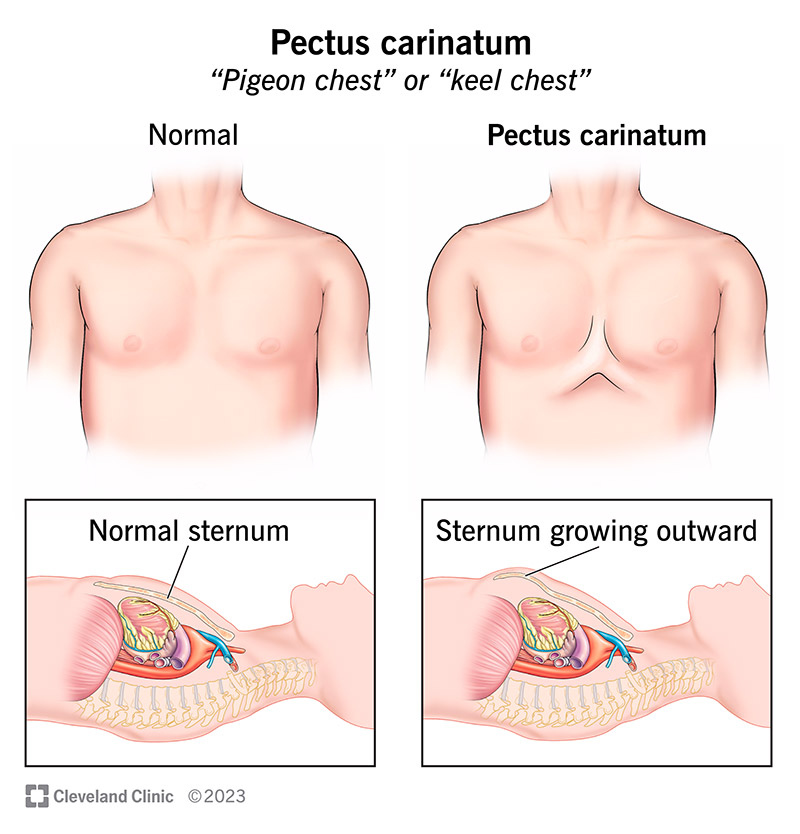Pectus carinatum is a condition that makes your breastbone stick out beyond where it should. The causes are unclear, but surgical and nonsurgical treatments can correct this issue. You may have physical symptoms or low self-esteem from pectus carinatum. Treatments can help with both.
Advertisement
Cleveland Clinic is a non-profit academic medical center. Advertising on our site helps support our mission. We do not endorse non-Cleveland Clinic products or services. Policy

Pectus carinatum is a condition in which your sternum (breastbone) sticks out more than usual. Some people call it “pigeon chest” or “keel chest” because of how it makes your chest look. It’s the opposite of pectus excavatum, in which your breastbone is depressed inward and gives your chest a sunken appearance.
Advertisement
Cleveland Clinic is a non-profit academic medical center. Advertising on our site helps support our mission. We do not endorse non-Cleveland Clinic products or services. Policy
Healthcare providers recognize two main pectus carinatum types:
Providers may also talk about whether the condition affects both sides of your chest (symmetric) and if your sternum rotates to one side.
Pectus carinatum affects about 1 in 1,000 people. But it may be even more common. Some estimate that 1 in 300 people have it.
It’s more common in men than women. Although the condition is present at birth, people often notice it during their teen years.
Most people with pectus carinatum have no symptoms. They may have some chest pain associated with certain activities and positions.
Pectus carinatum isn’t dangerous and doesn’t impact life expectancy.
Researchers don’t know the exact cause of pectus carinatum. But they believe it’s a disorder of the cartilage that joins your ribs to your breastbone.
Researchers haven’t found a genetic issue yet, but they may in the future. Up to 33% of people with pectus carinatum have a family history of a chest wall issue.
Advertisement
Pectus carinatum has an association with:
Complications of pectus carinatum may include:
A healthcare provider will take your medical history and perform a physical examination. They may also check to see if you have scoliosis. Then they’ll order tests if they need to.
The main test for diagnosing pectus carinatum is a chest X-ray from the front and side. Other tests may include:
Bracing and surgery are the pectus carinatum treatment options for people who want correction. Bracing is a nonoperative intervention that’s generally more effective in children. It requires compliance with the use of a brace, which can be challenging for children.
This works like the way braces work on teeth. You wear the brace around your chest under or on top of your clothes. The brace provides pressure from both the front and back to move the breastbone back to its usual position. You wear it for up to 24 hours a day, for a period of six months to years. You can remove it for showering, sports and other activities.
A brace works best before a growth spurt because your chest wall is still flexible.
This involves a technique called the Ravitch procedure. A surgeon makes an incision (cut) in the mid-chest area to remove cartilage in the front of your chest. They make a small cut in the front of your sternum and depress your sternum to a normal position. The surgeon anchors it into position with various techniques including sutures, plates or a bar.
A surgeon can use a minimally invasive surgery that’s similar to a Nuss procedure. They use a metal bar to depress your sternum. They leave the bar in for one or more years and remove it in a separate surgical procedure.
Surgeons have modified these procedures in different ways, but they usually secure the breastbone in some way.
Bracing treatment for pectus carinatum is very safe. A small number of people may have irritation or breakdown of the skin where the brace touches it. If this happens, you can stop using the brace at the first sign of any irritation. Then you can ask your provider to adjust the brace.
The surgical repair of pectus carinatum, like other extensive surgeries, carries certain risks. Both the Ravitch and Nuss procedures are safe and effective. But complications can happen, including:
Advertisement
After surgery, you may be in the hospital for one to five days. You’ll have a follow-up appointment with your surgeon after a few weeks.
No. Until researchers can clearly identify what causes pectus carinatum, you can’t prevent it. Some of the possible causes involve the genes you inherit from your parents, which you can’t change.
Pectus carinatum doesn’t adversely affect life expectancy. For most people, it’s primarily a cosmetic issue (although symptoms can occur).
The outlook for people who have pectus carinatum is generally very good. People who wear a brace or have the surgery are usually very satisfied with the results and their appearance.
People who have pectus carinatum generally live a normal life and shouldn’t limit their activities unless they experience discomfort.
You should see a healthcare provider if your pectus carinatum is getting in the way of your daily life. And don’t neglect your mental health. If you’re self-conscious about your chest and it’s affecting your self-esteem, correction can be beneficial.
Advertisement
Questions to ask your healthcare provider may include:
Fitting in at school can be difficult for any teen. But having a chest that looks different can make you feel self-conscious. If pectus carinatum makes you feel this way, talk to a counselor about it. You don’t need to handle this alone. If you want to get treatment for pectus carinatum, see a healthcare provider who can talk with you about your options.
Advertisement
As your child grows, you need healthcare providers by your side to guide you through each step. Cleveland Clinic Children’s is there with care you can trust.

Last reviewed on 08/11/2023.
Learn more about the Health Library and our editorial process.